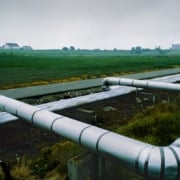U.S. EPA Sets Stricter National Ambient Air Quality Standards for Particulate Matter
On February 7, 2024, the U.S. Environmental Protection Agency (EPA) issued a final rule under the Clean Air Act lowering the primary (health-based) annual National Ambient Air Quality Standard (NAAQS) for fine particulate matter 2.5 micrometers in diameter or smaller (PM2.5) from 12 to 9 micrograms per cubic meter (µg/m3). EPA asserts that the stricter standard is based on scientific evidence showing that the current PM2.5 standard (12 µg/m3), which was established in 2012 and retained in 2020, does not sufficiently protect human health. According to EPA, based on air monitoring data from 2020-22, 119 counties would not meet the new standard of 9 µg/m3.
The rule also revises the Air Quality Index reporting requirements from five to seven days a week for metro areas with more than 350,000 people. Last, the new rule modifies monitoring requirements to include siting at least one monitor in an at-risk community. The new rule does not change any other air quality standards for particulate matter (i.e., the primary 24-hour PM2.5 standard or PM10 (coarse particulate matter) standard or the secondary PM2.5 and PM10 standards).
The new standard will become effective 60 days after the final rule publishes in the Federal Register. Then EPA will make designations of areas in attainment and nonattainment (which will be subject to public comment) within the next two years.
- Areas designated in attainment must update Prevention of Significant Deterioration stationary source permitting requirements to ensure maintenance of the new standard.
- Areas that fail to meet the new PM5 NAAQS of 9 µg/m3 are initially classified as being in “moderate” nonattainment.
- Following final designations, nonattainment areas must impose Nonattainment New Source Review permitting requirements for construction of major stationary sources. States with moderate nonattainment areas are required to adopt and submit State Implementation Plans (“SIPs”) within 18 months of the nonattainment designations showing how they will meet the revised standard. These new designations may require sources to purchase costly offsets that may be difficult to obtain.
States will have six years to achieve the new NAAQS (i.e., by 2032). After that, if a state has not achieved attainment, the state’s nonattainment status will be downgraded from “moderate” to “serious.” Under certain circumstances, states that cannot meet the 2032 deadline may qualify for up to two one-year extensions.
The stricter standards and heightened monitoring and reporting requirements will likely create additional compliance costs, particularly for facilities in areas with annual ambient PM2.5 levels of between 9 and 12 µg/m3. The increased emphasis on environmental justice monitoring may also be a relevant factor in deciding where to construct and operate facilities, as a source potentially faces greater uncertainty, delays, and higher costs to permit facilities near communities that EPA classifies as overburdened.
The final rule follows the proposed rule issued on January 6, 2023, for which EPA received nearly 700,000 written public comments. Indeed, EPA has been working toward the revised standards since President Joe Biden issued Executive Order 13990, “Protecting Public Health and the Environment and Restoring Science to Tackle the Climate Crisis,” on January 20, 2021, which directed EPA to review and revise the standard.
This post is as of the posting date stated above. Sidley Austin LLP assumes no duty to update this post or post about any subsequent developments having a bearing on this post.



